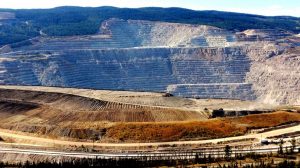Chapter 18. Geological Resources
Chapter Goals
Complete this chapter so you can:
- Describe the importance of geological resources to our way of life.
- Summarize the types of materials mined in Canada and explain some of the processes involved in the formation of metal deposits.
- Explain how a metal deposit is developed into a mine.
- Define acid rock drainage (ARD) and discuss why some mines can lead to ARD and contamination of the environment by metals.
- Summarize some of the important industrial materials extracted in Canada and describe what they are used for.
- Describe the processes that lead to the formation of coal deposits.
- Explain the processes that lead to the formation of oil and gas, the distinction between source rocks and reservoir rocks, and the importance of traps.
- Describe the origins and recovery of some of the unconventional fossil fuels.
- Describe the origins, discovery, and extraction of diamonds in Canada.
If You Can’t Grow It, You Have to Mine It
It’s been said that “if you can’t grow it, you have to mine it,” meaning that anything we can’t grow we have to extract from Earth in one way or another. This includes water, our most important resource, but it also includes the materials that we need to construct things like roads, dams, and bridges, or manufacture things like plates, toasters, and telephones. Most of our energy resources come from the Earth, including uranium and fossil fuels, and much of the infrastructure of this electrical age depends on copper (Figure 18.1).

Virtually everything we use every day is made from resources from Earth. Consider a tablet computer (Figure 18.2):
![Figure 20.2 The main components of a tablet computer [SE, base photograph from https://upload.wikimedia.org/wikipedia/commons/8/8d/IPad_Air.png]](https://opentextbc.ca/kzlab/wp-content/uploads/sites/360/2021/08/main-components-of-a-tablet-computer.png)
- Most of the case is made of the plastic known as ABS, which is made from either gas or petroleum. Some tablets have a case made from aluminum.
- The glass of a touch screen is made mostly from quartz combined with smaller amounts of sodium oxide (Na2O), sodium carbonate (Na2CO3), and calcium oxide (CaO).
- To make it work as a touch screen, the upper surface is coated with indium tin oxide. When you touch the screen you’re actually pushing a thin layer of polycarbonate plastic (made from petroleum) against the coated glass, completing an electrical circuit. The computer is then able to figure out exactly where you touched the screen.
- Computer processors are made from silica wafers (more quartz) and also include a significant amount of copper and gold. Gold is used because it is a better conductor than copper and doesn’t tarnish the way silver or copper does.
- Most computers have nickel-metal-hydride (NiMH) batteries, which contain cadmium, cobalt, manganese, aluminum, and the rare-earth elements lanthanum, cerium, neodymium, and praseodymium, in addition to nickel.
- The processor and other electronic components are secured to a circuit board, which is a thin layer of fibreglass sandwiched between copper sheets coated with small amounts of tin and lead. Various parts are put together with steel screws that are made of iron and molybdenum.
That’s not everything that goes into a tablet computer, but to make just those components we need a pure-silica sand deposit, a salt mine for sodium, a rock quarry for calcium, an oil well, a gas well, an aluminum mine, an iron mine, a manganese mine, a copper-molybdenum-gold mine, a cobalt-nickel mine, a rare-earth element and indium mine, and a source of energy to transport all of the materials, process them, put them together, and finally transport the computer to your house or the store where you bought it.

